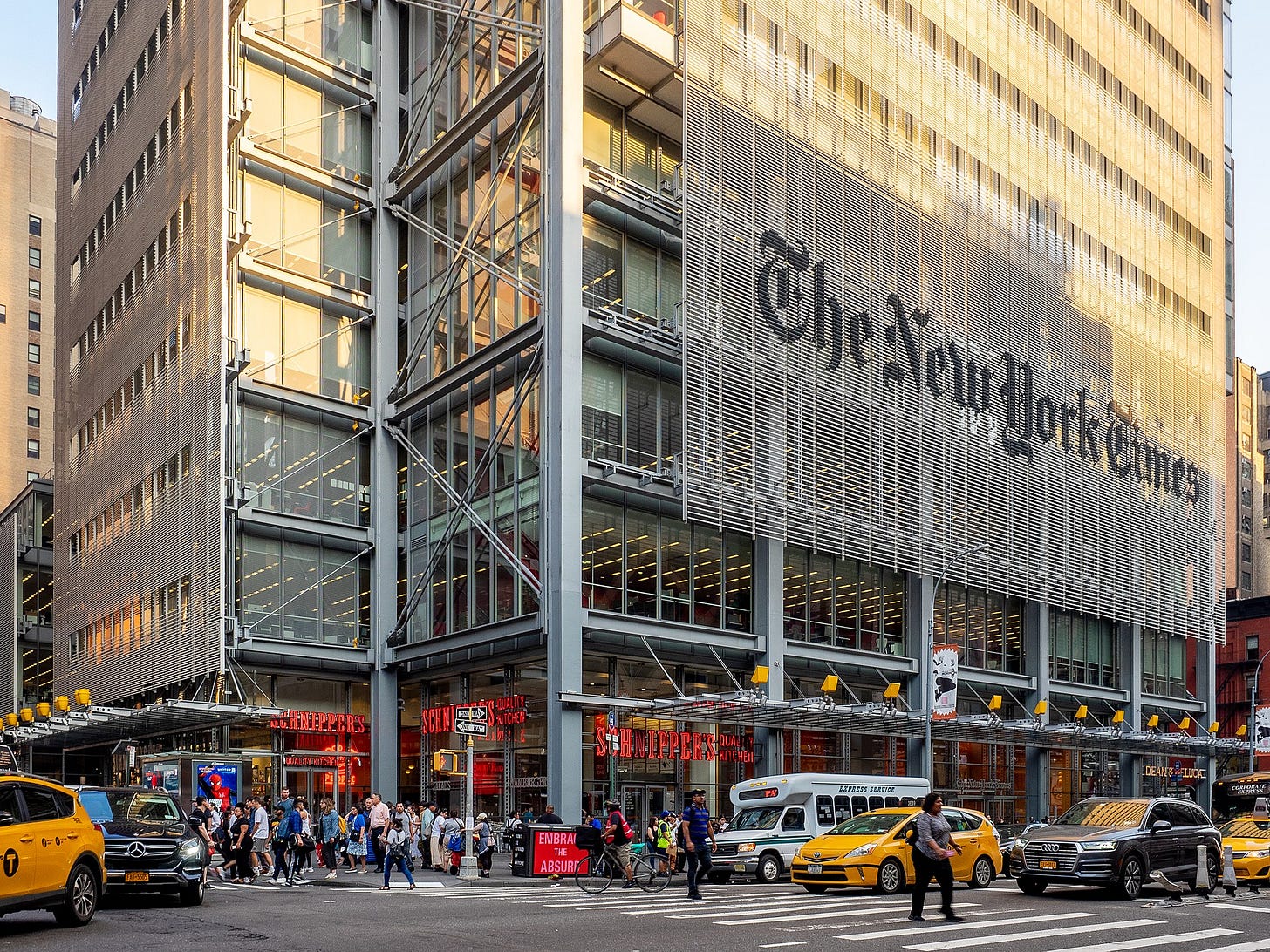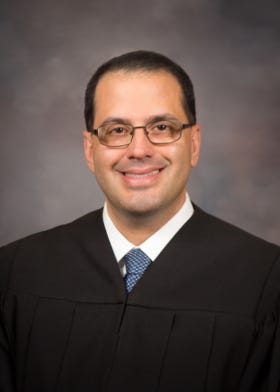‘The worst of advocacy journalism’: Did the New York Times smear an esteemed federal judge?
Imagine a man who overcame poverty and serious illness to become an accomplished legal scholar and federal judge. Admired across ideological lines, he has developed a reputation for fairness, a strong sense of duty, and a commitment to mentoring disadvantaged youth. He also teaches law students in his spare time.
That’s the real story of Judge John Badalamenti, a respected jurist and educator. Yet in a recent article, the New York Times cast him in a far darker light, in a story under the deeply misleading headline: “A White Nationalist at University of Florida Wrote a Paper Promoting Racist Views. It Won Him an Award.”
The article by Richard Fausset goes beyond the presentation of facts and deals instead in innuendo and imputation—speculating, without evidence, that Judge Badalamenti sympathized with the views expressed in a controversial student paper simply because the paper received a high grade in his seminar.
Perhaps because the story is set at the University of Florida–thanks to its association with conservative figures like Ron DeSantis and Ben Sasse, a lightning rod for the culture war debates about the future of higher ed–the Times can’t help itself but to contort routine academic evaluation with ideological endorsement, in ways that have already had serious consequences for Badalamenti’s reputation, not to mention his safety.
Academic standards vs. ideological assumptions
The story centers on a paper submitted by University of Florida law student Preston Damsky in Badalamenti’s seminar on originalism, a method of constitutional interpretation focused on the text’s original public meaning. The paper argued that the phrase “We the People” in the Constitution’s preamble originally referred only to white Americans, and from this premise derived an argument for exclusionary immigration policies.
The paper’s conclusions are extreme and controversial. But as constitutional law professor Josh Blackman and others have pointed out, the academic criteria for grading law school papers are separate from the personal views expressed therein. These criteria include historical grounding, analytical rigor, and citation integrity. On those grounds, Blackman found the paper technically sound, if imperfect: “Probably a B+ or maybe an A- if I was feeling generous,” he wrote in an independent analysis.
This independent assessment of Damsky’s paper illustrates that law students–whatever their political views may be–are graded based on their ability to make arguments, analyze scholarship, and accurately deploy legal precedent. Damsky earned a high grade because Badalamenti, an eminent legal scholar, believed he met those requirements. Moreover, the book award he received is a common honor in law school routinely awarded to the student with the highest overall score in a seminar.
The Times piece implies that Badalamenti selected Damsky for special recognition because he was sympathetic to the ideology underlying the arguments in this specific paper. That implication is blatantly deceptive. “Fausset obviously has no idea how law school seminars are graded, and made no effort to learn,” Blackman added.
Nothing in the evidence presented suggests that Badalamenti offered the award because he found the paper’s views admirable. In fact, the interim dean of the University of Florida Law School, Merritt McAlister, explicitly confirmed that Badalamenti “took the paper on its face—as a student paper attempting to use originalist methodology to reach a detestable and extreme position.” More importantly, McAlister explained that:
The paper’s views also in no way reflect the views of the professor in this course. The professor had no knowledge of this student’s history at the law school or his deeply held personal views.
Badalamenti’s other students have said the same thing. "I am beyond certain from my time spent with Judge Badalamenti that he grades papers as impartially as any human possibly could,” one student said, “even if he has to hold his nose at some of the views espoused to recognize a well written, researched, and organized paper …”
This kind of detachment is not only common in academia—it’s vital. Grading ideas you disagree with is a core part of academic discourse and undergirds academic freedom. Several former students of Badalamenti attested that he took this obligation seriously and evaluated work impartially.
Misleading implications
A more troubling omission in the Times article is the timeline. Crucially, Damsky’s personal views did not surface on social media until February 2025, with the most egregious statements appearing in March 2025. Badalamenti graded his paper, two months earlier, in December 2024. The Times cites Damsky’s social media comments but omits this timeline, allowing readers to falsely infer that Badalamenti knowingly rewarded a white supremacist who was making inflammatory public statements. This omission is hard to defend as a mere oversight and looks more like a deliberate choice to sensationalize the story and fuel outrage.
That’s not just misleading—it risks undermining the very norms of fair and responsible reporting that journalists have long held sacred. At a bare minimum, the Times owed its readers simple clarity on the facts. Blackman’s own conclusion was more stark. The Times piece “represents the worst of modern-day advocacy journalism,” he noted.
Reputation and context
Perhaps more importantly, the Times piece ignores essentially everything we know about Badalamenti. The judge is a distinguished legal expert whose career is marked by high-quality scholarship and bipartisan respect. A former federal public defender, he has successfully argued a case before the Supreme Court. His seminar on originalism, co-taught at the University of Florida, attracted top scholars and jurists, including the entire Florida Supreme Court and Eleventh Circuit judges, reflecting his stature in the legal community.
Moreover, Badalamenti’s personal history unequivocally refutes any suggestion that he sympathizes with white supremacy. He serves as a mentor to young African American boys through his work with Gentlemen’s Quest, a nonprofit helping high-risk high school students gain college access. According to the organization’s website, he is the only white member of its board. His Senate Judiciary Committee questionnaire further highlights his volunteer work mentoring inner-city middle school students in Tampa, Florida.
These are not incidental facts or fluff. In light of the Times’ highly inflammatory characterization, they are crucial context—and their exclusion does a disservice to readers seeking a fair and complete understanding.
A broader concern
Leaks from the Times internal battles over the extent to which its journalism should be driven by political advocacy have created their own headlines in recent years. This is the same paper that allowed its reporting staff to force a seasoned editor out of his job for publishing an op-ed by a Republican senator.
So perhaps it’s unsurprising that the real target of the Badalamenti hit seems to be originalism itself. The Times mentions the conservative-coded judicial philosophy multiple times throughout the piece, including in the very first line of the article. The term is always used to tie Badalamenti’s seminar to Damsky’s fringe views, suggesting that originalism itself is inherently flawed or sympathetic to racism. Other major news outlets framed their coverage the same way. “Originalism’s flaws include its racist underpinnings,” another recent headline averred.
Blackman predicts that the consequence of this piece will be that other originalist scholars may avoid teaching altogether to avoid reputational damage—as well as the credible death threats Badalamenti received. This would deny future lawyers any exposure to a legal philosophy that has profoundly influenced American jurisprudence. “Make no mistake, this is a feature, and not a bug about these attacks on originalism,” Blackman concluded.
A final word
None of this is to suggest that hate speech or bigotry should be ignored or minimized. But in our concern about extremism, we should be equally careful not to abandon basic principles of fairness and evidence-based reporting. The article in question invites readers to draw grave conclusions based on flimsy innuendo and outright distortion rather than fact—and in doing so, it has unfairly smeared a person whose actions, viewed in context, reflect professional integrity and an educator’s commitment to open discourse.
The Times can and should do better. So should we all.




